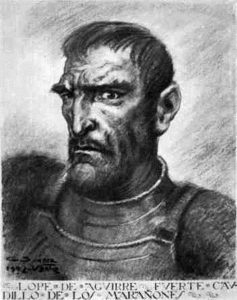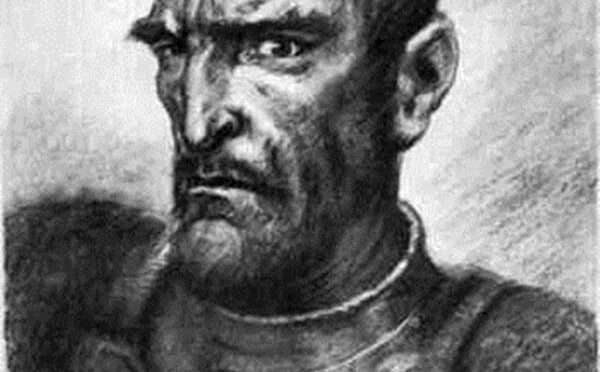Basques played a significant role in the exploration and conquest of the Americas. Lope Agirre is perhaps one of the most notorious of those Basques. Originally from the province of Gipuzkoa, he was enticed by the potential riches the Americas promised. He rose to power and even tried to declare war with and independence from the crown. A violent man himself, he met a violent end at the age of 50.

- Lope Agirre was born in the town of Oñati, Gipuzkoa on November 8, 1510. He was the son of a nobleman, but not much else is known. In fact, there are debates as to both his birthplace and birth year. What is clear, however, is that he found himself in Sevilla when Hernando (or Francisco) Pizarro returned from Peru with stories of vast wealth. Agirre signed up for an expedition and arrived in Peru around 1536.
- He began his time in the Americas as a horse tamer in Cuzco, where he was an alderman, and was part of the founding of La Plata.
- In 1544, viceroy Blasco Núñez Vela was sent from Spain to implement the New Laws and to free the native slaves. However, many conquistadors resisted these changes, going so far as to imprison Núñez Vela. Agirre allied himself with Núñez Vela, taking part in an effort to free the viceroy.
- The viceroy was eventually defeated and Agirre traveled across the region, to Nicaragua and back to Peru. There he was arrested and tried for breaking the laws that protected the natives. He was sentenced to a public flogging. Once the presiding judge’s term ended, Agirre tracked him for three years as he fled, walking some 3,700 miles barefoot. Finally, Agirre found him in Cuzco where Agirre stabbed him with his dagger.
- In 1560, Agirre joined the expedition of Pedro de Ursúa to look for El Dorado, the City of Gold. He took part in the overthrow and killing of Ursúa, taking over the expedition. He carried out several more assassinations to keep his power. When they reached the Atlantic, wreaking havoc on the native populations in their wake, he had his men declare that he was prince of Peru. This is considered the first act of independence in the Americas. He took island of Margarita and tried to take Panama. When his rebellion against the Spanish Crown failed, he killed his own daughter Elvira, who had accompanied him on the expedition, as he couldn’t bear to see someone he so loved fall into the hands of such vile people.
- Agirre was captured by Spanish forces and shot by his own soldier. His body was beheaded and cut into quarters and sent to neighboring towns as a warning against revolt.
- Agirre was known for his cruelty and harshness. He called himself the “Wrath of God, Prince of Freedom.” Others called him the “Madman of Onate.”
A full list of all of Buber’s Basque Facts of the Week can be found in the Archive.
Primary sources: Estornés Lasa, Mariano. Agirre, Lope (1511-1561). Auñamendi Encyclopedia, 2024. Available at: https://aunamendi.eusko-ikaskuntza.eus/en/agirre-lope-1511-1561/ar-6962/; Lope de Aguirre, Wikipedia; Lope de Aguirre, Wikipedia
Discover more from Buber's Basque Page
Subscribe to get the latest posts sent to your email.



Source of the name of the famous Herzog film “Aguirre, The Wrath of God”
WOW! Greetings, speaking of Onate. From UC Berkeley, Cibola Project, the inventory of Juan de Onate’s expedition to NM.
Title: Juan de Salazar’s Inspection of Juan de Onate’s Equipment and Personnel Destined for the Conquest of Nuevo Mexico November 16. 1957-February 2, 1958
Authors: De Marco, Barbara and Craddock, Jerry R
Permalink: https://escholarship.org/ucitem/4wt8m665
Supplemental Material https://escholarship.org/ucitem/4wt8m665#supplemental
Facsimiles published in accordance with an agreement between the California Digital Library and Espana Ministerio de Educacion, Cultura y Deporte Archivo de Indias , Sevilla . ( sorry I do not know how to insert accents). It is in the original Spanish but now written in Word. Two pages in English explains the process. He is mentioned also as Joan de Haro. He was from the powerful house of Haro.
Have fun.
Monique
Incredible!!